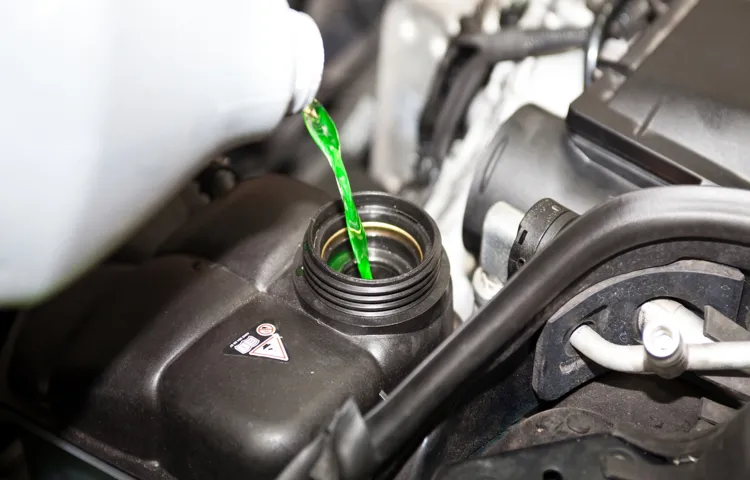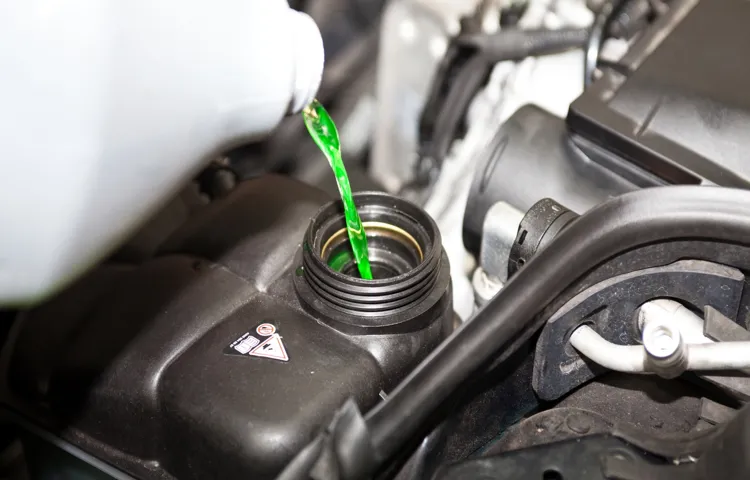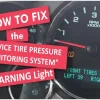So, you’ve just added coolant to your car’s engine. It’s a small but vital step in maintaining your vehicle’s performance and longevity. But what should you do next? Should you just close the hood and go on with your day? Or is there more to it? In this blog post, we’ll explore what comes after adding coolant and why it’s important to pay attention to these next steps.
So buckle up and let’s dive in!
Table of Contents
Check the Coolant Level
So, you’ve just added coolant to your vehicle – well done! But you’re probably wondering what to do next. One important step after adding coolant is to check the coolant level in your car’s reservoir. This is crucial because the coolant is responsible for regulating your engine’s temperature, and if it’s too low, it can lead to overheating and potential engine damage.
To check the coolant level, start by locating the coolant reservoir, which is usually a translucent plastic tank near the radiator. The reservoir will have minimum and maximum level markings, so you can easily determine if the coolant level is within the recommended range. To get an accurate reading, make sure your engine is cool before removing the radiator cap or opening the coolant reservoir.
If the engine is still hot, you could risk burning yourself with hot coolant spewing out under pressure. Once the engine is cool, carefully remove the radiator cap or open the coolant reservoir. Use a flashlight if necessary to see inside the reservoir and check if the coolant is at the correct level.
If it’s too low, you can top it up with more coolant or a mixture of coolant and water. Just make sure to use the appropriate coolant for your vehicle, as specified in your owner’s manual. After adding coolant, don’t forget to securely tighten the radiator cap or close the coolant reservoir.
This will prevent any leaks and ensure that the coolant can do its job effectively. Now that you’ve checked and topped up the coolant level, you can rest easy knowing that you’ve taken an important step in maintaining your vehicle’s cooling system. Just remember to regularly check the coolant level and monitor your engine’s temperature to prevent any issues down the road.
Verify that the coolant level is within the recommended range by consulting the vehicle’s owner manual. If the level is too low, add more coolant until it reaches the proper level.
When it comes to maintaining your vehicle, checking the coolant level is crucial. The coolant is responsible for keeping your engine at the right temperature and preventing it from overheating. To ensure that the coolant is at the proper level, you should consult your vehicle’s owner manual.
This manual will provide you with the recommended range for the coolant level. If the level is too low, it’s essential to add more coolant until it reaches the right mark. Think of it as giving your car a refreshing drink to keep it cool and running smoothly.
Just like you wouldn’t want to get dehydrated on a hot day, your car’s engine needs the right amount of coolant to stay hydrated and perform at its best. So, take a few minutes to check the coolant level and make sure it’s within the recommended range. Your car will thank you for it!

Inspect for Leaks
Once you have added coolant to your vehicle, it’s important to inspect for any leaks. Even if the coolant level is low and you have topped it up, there may still be a leak that needs to be addressed. Start by checking the ground underneath your vehicle for any signs of coolant.
A small puddle or wet spot could indicate a leak. Next, check the engine compartment for any visible signs of coolant leakage. This could include wet spots or stains on the hoses, radiator, or water pump.
If you notice any leaks, it’s important to have them repaired as soon as possible. Coolant leaks can lead to overheating and engine damage if left unchecked. It’s always better to be proactive and address any leaks right away to ensure the proper functioning of your vehicle’s cooling system.
Look for any signs of coolant leaks, such as puddles or stains under the vehicle. If there are any leaks, they should be addressed immediately to prevent further damage to the cooling system.
If you’re planning to buy a used car or just want to keep your current vehicle in top shape, it’s important to regularly inspect for coolant leaks. These leaks can cause serious damage to your cooling system and lead to overheating, which can be a costly repair. One of the easiest ways to check for coolant leaks is to look for any puddles or stains underneath your vehicle.
Coolant typically has a bright green or orange color, so it’s relatively easy to spot. If you notice any leaks, it’s crucial to address them right away to prevent further damage. Remember, prevention is always better than cure when it comes to your vehicle’s cooling system.
Run the Engine
So, you’ve just added coolant to your engine. Great job! But what do you do next? Well, the first thing you’ll want to do is run the engine. This will help circulate the coolant throughout the system and ensure that it is distributed evenly.
Plus, running the engine will also help to check for any leaks or other issues that may have caused the coolant to run low in the first place. And while you’re at it, it’s always a good idea to keep an eye on the temperature gauge. Make sure it doesn’t get too high, as this could be a sign of a problem with the cooling system.
So, go ahead and start that engine and let it run for a few minutes. Your car will thank you!
Start the engine and let it run for a few minutes. This will allow the coolant to circulate through the system and reach all the necessary components.
Starting the engine is a crucial step in the coolant circulation process. Think of it as waking up your car’s vital organs and getting them ready for action. When you turn that key in the ignition, you’re essentially kickstarting a beautiful symphony of mechanical marvels.
As the engine roars to life, it sets off a chain reaction of events that lead to the coolant flowing through every nook and cranny of your car’s cooling system. Just like an orchestra conductor bringing the musicians together, starting the engine allows the coolant to energize and reach all the necessary components. So, don’t forget to give your engine a few minutes to warm up and let the coolant do its thing before hitting the road.
After all, a well-circulated coolant means a happy and healthy car.
Check the Temperature
So, you’ve added coolant to your car’s radiator, but now what? Well, the next step is to check the temperature. It’s important to make sure that the engine is not overheating, as this can cause serious damage to your vehicle. One way to check the temperature is by using a thermometer specifically designed for automotive use.
Simply place the thermometer in the radiator and wait for it to give you a reading. If the temperature is within the normal range, then you’re good to go. However, if the temperature is too high, it may indicate a problem with your cooling system.
In this case, it’s best to consult with a professional mechanic who can diagnose the issue and recommend the appropriate repairs. Remember, it’s always better to be safe than sorry when it comes to your vehicle’s temperature.
Monitor the temperature gauge on the dashboard to ensure that the engine is not overheating. If the temperature starts to rise significantly, turn off the engine and let it cool down before continuing.
Monitoring the temperature gauge on your car’s dashboard is an essential part of ensuring that your engine doesn’t overheat. It’s like keeping an eye on your body temperature when you’re feeling under the weather. Just like a high temperature can signal a fever, a significant rise in your car’s engine temperature can be a warning sign of trouble.
If you notice that the temperature starts creeping up, it’s important to take action immediately. Just as you would turn off a stove burner if it’s getting too hot, you should turn off your engine and let it cool down before continuing on your journey. Ignoring an overheating engine can lead to serious damage and expensive repairs.
So, remember to keep an eye on that temperature gauge and give your car the TLC it deserves.
Take a Test Drive
So, you’ve just added coolant to your car’s engine, and now you might be wondering what to do next. Well, the first thing you should do is take it for a test drive. This might seem a bit counterintuitive, but it’s actually an important step in ensuring that the coolant is doing its job properly.
Taking your car for a spin will allow the coolant to circulate throughout the engine, cooling down all the essential components. It will also give you a chance to monitor the temperature gauge and make sure that it stays within the normal range. If you notice any signs of overheating, such as a rising temperature gauge or steam coming from under the hood, you’ll want to pull over and let the engine cool down before continuing.
The test drive is also a great opportunity to listen for any unusual noises or vibrations. Sometimes, a coolant issue can cause a gurgling or bubbling sound in the engine, indicating that there may still be air pockets or a blockage in the coolant system. If you hear anything out of the ordinary, it’s best to have a professional take a look at it to ensure that everything is functioning properly.
In addition to monitoring for overheating and listening for any strange noises, you should also pay attention to the performance of your car during the test drive. If you notice any changes in acceleration, power, or fuel efficiency, it could be a sign that there is an underlying issue that needs to be addressed. Keep an eye out for any warning lights on the dashboard as well, as they can provide valuable information about the health of your vehicle.
In conclusion, taking your car for a test drive after adding coolant is an important step in ensuring that your engine stays cool and your vehicle performs optimally. By monitoring the temperature gauge, listening for unusual noises, and paying attention to any changes in performance, you can catch any potential issues early on and prevent further damage. So, go ahead and hit the road – your car will thank you for it!
Go for a short drive to ensure that the vehicle is running smoothly and the engine is not overheating. Pay attention to any unusual noises or vibrations.
When test-driving a car, it’s important to go for a short drive to make sure everything is running smoothly. You don’t want to end up with a car that has engine problems or is constantly overheating. So, hop in the driver’s seat and hit the road to see how the vehicle performs.
Pay close attention to any unusual noises or vibrations that you might notice while driving. These could be signs of potential issues that you definitely want to avoid. Think of it as taking the car for a spin to see how it handles and whether it feels comfortable to drive.
Just like when you’re trying on a new pair of shoes, you want to make sure the fit is perfect. So, take the car for a test drive to ensure it meets all your expectations.
Check the Coolant Level Again
Now that you’ve added coolant to your vehicle, it’s important to double-check the coolant level to ensure you’ve added enough. After adding coolant, wait for the engine to cool down before opening the hood. Once the engine has cooled, locate the coolant reservoir, which is typically a plastic tank near the radiator.
The reservoir should have minimum and maximum marks indicating the appropriate coolant level. Use a flashlight if needed to get a clear view of the markings. If the coolant level is below the minimum mark, you’ll need to add more coolant.
However, if the level is near the maximum mark, you’ve added enough coolant and can close the reservoir cap securely. It’s crucial to maintain the correct coolant level in your vehicle to prevent overheating, so check the coolant level regularly to ensure it stays within the recommended range.
After the engine has cooled down, check the coolant level once more. It may have decreased slightly as air bubbles were released during the initial circulation process. Add more coolant if necessary.
As you’re wrapping up the process of maintaining your car’s cooling system, it’s important to give the coolant level one final check. After the engine has had some time to cool down completely, it’s common for the coolant level to have slightly decreased. This is due to air bubbles being released during the initial circulation process.
To ensure optimal performance, it’s crucial to have the correct amount of coolant in the system. So, pop open the hood once more and take a look at the coolant reservoir. If the level is below the recommended range, you’ll need to add more coolant.
Simply pour it in until the level reaches the appropriate mark. By performing this final step, you’ll be giving your car’s cooling system the best chance at keeping your engine running smoothly and efficiently.
Schedule a Maintenance Check
So, you’ve added coolant to your car and you’re wondering what to do next? Well, it’s always a good idea to schedule a maintenance check with your trusted mechanic. Adding coolant is an important step in keeping your engine cool and preventing overheating, but it’s not the only thing that needs to be checked. During a maintenance check, your mechanic will inspect your car for any other issues that may need attention, such as leaks, worn-out hoses, or a malfunctioning thermostat.
They will also check the overall health of your cooling system to ensure that everything is working properly. Remember, regular maintenance is key to keeping your car in top shape and preventing any major breakdowns or costly repairs down the line. So, don’t forget to schedule that maintenance check after adding coolant to your car!
If you had to add coolant due to a significant loss or if you notice recurring coolant leaks, it is recommended to schedule a maintenance check with a qualified mechanic to identify and fix any underlying issues.
If you’ve recently had to add coolant to your vehicle due to a significant loss or if you keep noticing recurring coolant leaks, it’s important to take action and schedule a maintenance check with a qualified mechanic. While adding coolant occasionally is normal, having to do it frequently indicates a potential problem that needs to be addressed. A maintenance check will allow a mechanic to thoroughly inspect your vehicle and identify any underlying issues that may be causing the coolant leaks.
By fixing these issues promptly, you can prevent further damage to your engine and avoid costly repairs down the line. So, don’t wait. Make an appointment today to ensure your vehicle is running smoothly and efficiently.
Conclusion
After adding coolant to your vehicle, many people wonder what to do next. Do you throw a party and celebrate the successful infusion of liquid gold into your car’s veins? Well, as enticing as that may sound, there are a few more steps to ensure the optimal performance of your cooling system. Firstly, make sure to securely close the coolant reservoir cap.
Just like sealing a treasure chest, you want to prevent any precious coolant from escaping and evaporating into thin air. Remember, coolant should be flowing through your engine, not disappearing into the great unknown! Next, it’s time to start up your engine and let it roar like a content lion with its newfound coolant energy. Allow the engine to warm up gradually to operating temperature, giving the coolant a chance to circulate throughout the entire cooling system.
This is where the magic happens, folks! While your engine purrs with delight, keep an eye on the temperature gauge, just like a hawk watching its prey. If you notice any abnormal spikes in temperature or unusual behavior from your cooling system, it’s time to play detective and solve the mystery of the overheating car. But fear not, cool-headed sleuth! It could simply be a trapped air bubble in the system that needs to be released.
Just gently squeeze the upper radiator hose a few times (with gloves on, of course) to help the trapped air escape, and voila, your engine will breathe a sigh of relief! Lastly, don’t forget to regularly check your coolant levels to ensure a healthy cooling system. You wouldn’t want your car to experience the equivalent of dehydration, would you? So, keep a watchful eye on that coolant reservoir and top it up whenever necessary. Consider it your car’s thirst-quenching beverage for optimum engine performance! So, my friends, after adding coolant, remember these steps and confidently embark on your journey knowing that your cooling system is as cool as a cucumber in a winter breeze.
And don’t worry, you can still raise a glass (of water, not coolant!) in celebration of a job well done. Cheers to a well-cooled engine and miles of trouble-free driving!”
FAQs
What should I do after adding coolant to my car?
After adding coolant to your car, you should check for any potential leaks in the cooling system. Inspect the hoses, radiator, and water pump for any signs of leakage. Additionally, it is important to monitor the coolant level regularly to ensure it remains at the appropriate level.
How often should I add coolant to my car?
The frequency of adding coolant to your car depends on various factors such as the type of coolant used, the condition of the cooling system, and the manufacturer’s recommendations. However, as a general rule of thumb, it is advisable to check the coolant level and top it up if needed during routine maintenance, which is usually every 6 to 12 months.
Can I mix different types of coolant?
It is generally not recommended to mix different types of coolant, especially if they have different chemical compositions. Mixing coolants can alter their properties and potentially lead to cooling system malfunctions or damage. To ensure optimum performance and avoid any potential issues, it is best to use the same type of coolant recommended by the car manufacturer.
How do I properly dispose of old coolant?
Old coolant should never be poured down the drain or thrown in the trash as it can be harmful to the environment. It is considered hazardous waste and should be taken to a designated collection center or recycling facility. Contact your local waste management authorities for guidance on the proper disposal methods available in your area.
What can cause coolant to disappear quickly?
There are multiple reasons why coolant may disappear quickly from the cooling system. Some common causes include a leaking radiator, a failing water pump, a cracked cylinder head or engine block, a damaged gasket, or a faulty thermostat. If you notice a significant decrease in coolant levels, it is advisable to have your car inspected by a professional mechanic.
Is it normal for coolant to evaporate over time?
While a small amount of coolant evaporation over time is considered normal, a significant decrease in the coolant level may indicate an underlying problem in the cooling system. It is important to regularly check the coolant level and top it up if needed to ensure proper engine cooling and prevent any potential damage.
Can coolant freeze in cold weather?
Yes, coolant can freeze in extremely cold weather conditions. It is crucial to use the appropriate coolant type and mixture recommended by the car manufacturer for your specific climate. Coolants with a lower freezing point and higher boiling point provide better protection against freezing and overheating, respectively. Installing a coolant/antifreeze tester can help you determine the freezing protection level of the coolant in your car.



